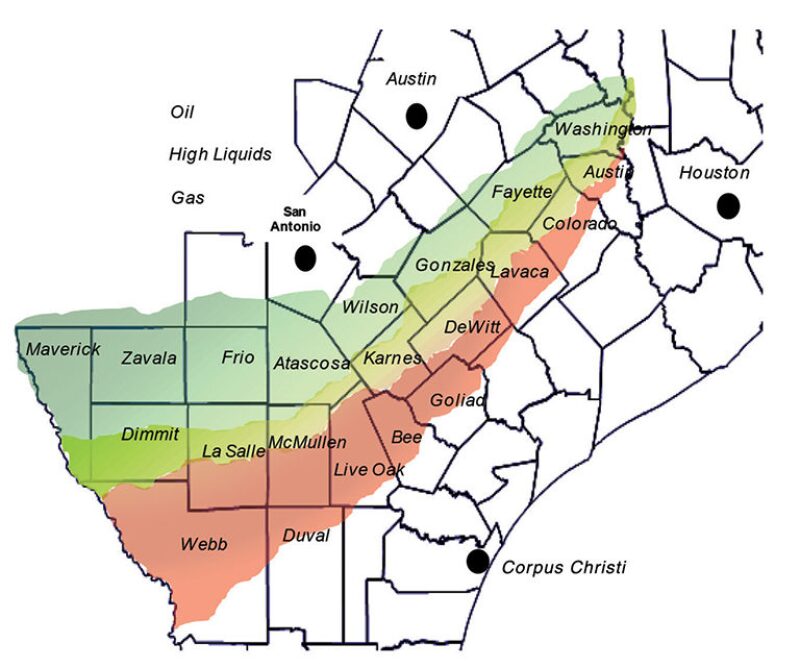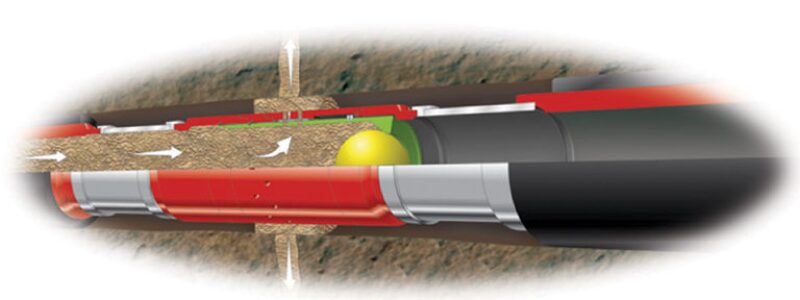The Eagle Ford shale in Zavala County, Texas, is similar to many high-carbonate-content oil-shale formations. As with other shale plays, the industry has preferred using cemented lateral sections as the primary means of fracture-stage isolation, coupled with the plug-and-perforate (PAP) horizontal-completion technique. An alternative completion method, cemented multistage sleeves (CMSSs), recently improved efficiency and reduced completion cycle time. The 16-stage stimulation operation was completed in 24 hours with continuous pumping compared with an average of 3 days for PAP.
Introduction
This paper highlights the key well (Fig. 1) that successfully implemented the new CMSS completion technique. The key well has been compared to averages from wells using the PAP technique to illustrate how the CMSS technique was able to achieve the completion goals while dramatically increasing completion efficiency. The subject well was drilled to a measured depth (MD) of 11,965 ft, with a lateral length greater than 5,913 ft, and was completed using 16 stages of CMSS technology to fracture stimulate the entire lateral section, which was placed in the Eagle Ford shale. The CMSS technology allowed for 3.80 million lbm of proppant to be placed with 2,901,000 gal of fluid to fracture stimulate the wellbore at an average rate of 54 bbl/min. The 15 stages of stimulation were completed in just 24 hours with continuous pumping operations, compared with an estimated 3 days for a PAP completion and 5 days for previous wells in Fayette County, Texas.

Challenge
A major challenge in unconventional reservoirs is developing more-efficient integrated completion methods to improve well economics and lower the cost per barrel of oil equivalent (BOE).
Wellbores previously completed with the PAP technique in Fayette County took an average of 5 days. These wells contained 15–20 fracture stages using a fracture design similar to that of the subject well. The challenge of reducing the completion cycle time was seen as an opportunity to improve efficiency and well economics. However, production must not be sacrificed. CMSS completion was used to evaluate whether the technique could achieve both goals.
The purpose of this case study was to evaluate the CMSS technology compared with PAP primarily on the basis of three criteria—reduction in total completion cycle time, elimination of nonproductive time (NPT) during the completion phase, and achieving production comparable with that of offset wells.
Completion Strategy and Background
The case-study subject well was to be drilled in the Eagle Ford shale play in a different field than the operator’s previous Eagle Ford wells. Even though this was a new area, CMSS technology was proposed for the 16-stage fracture completion, to improve efficiency. The CMSS would be run on a long string of production casing and cemented in place in the same way as the PAP wellbores. A similar stimulation design would be used to provide the best comparison of completion efficiency with respect to the wellbores that had previously used PAP technology.
The CMSS technology was selected because it consists of multistage fracturing sleeves that are activated from the surface, removing the need for wireline intervention. The CMSS method used a landing baffle and a composite ball that was released remotely into the fluid stream at the wellhead. The composite ball traveled in the fluid stream and seated on the corresponding landing baffle in the target sleeve. Increased pressure opened the sleeve, and the composite ball diverted fluid flow through ports in the outer casing of the sleeve and allowed stimulation to occur (Fig. 2). The composite ball isolated the target sleeve from any stages that had been fractured previously. Graduated ball and baffle sizes were used, starting with the smallest at the toe and continually increasing in size as distribution moved toward the heel of the wellbore. This allowed for numerous stages to be run in a single wellbore, with all remotely actuated from the surface. A hydraulically actuated toe sleeve was used to provide a flow path to pump the balls to the target sleeves and to pump the first fracture stage. This tool works from absolute or total pressure (hydrostatic plus applied) and was a sheared-pin-to-open type that was based on the pressures the tool would encounter during the cement job. The sleeves were cemented in place using acid-soluble cement, which assisted with fracture-creation efficiency (Fig. 3). The acid-soluble cement can be up to 90% dissolved by acid before the stimulation treatment, reducing near-wellbore tortuosity. An optimized ball-dropping procedure was also used that allowed for pressure indication at the surface of sleeve opening, that reduced overdisplacement of the previous fracture stages, and that enabled placement of the acid adjacent to the sleeve ports just before opening of the target sleeve. Additionally, a flexible wiper dart system was used to allow for effective removal of cement from the production casing during the cement job. These processes and tools assisted with the elimination of NPT during the completion cycle of the subject well.


Subject-Wellbore Design and Fracture Completion
The subject well consisted of a 10¾‑in. surface casing set at 3,010-ft MD and cemented back to the surface with conventional-cement slurry. The production-casing string consisted of a long string of 5½-in. casing with 16 CMSS-completion sleeves at equal spacing set at a depth of 11,965-ft MD. The production string was cemented back to the surface with conventional lead-cement slurry and an acid-soluble tail-cement slurry to isolate the lateral section. This was done inside an 8½-in. openhole section drilled from 3,010- to 11,965‑ft MD below the surface-casing string. A gelled proprietary cement-inhibition fluid was used in the displacement in case of any residual cement.
The stimulation design for the subject well consisted of 16 fracture stages to be pumped down the 5½-in. production casing through the CMSS completion. The total treated interval was from 7,522- to 11,695-ft MD. This was accomplished with a conventional fluid system using treated water and three proppant types (100-mesh, 30/50-mesh premium white, and 20/40-mesh premium white). The sleeve-shifting pressures, average treating pressures, and amount of fluid over or under calculated displacement to land each composite ball were also captured. The hydraulic sleeve at the toe of the wellbore was skipped and not fractured. The average pump time per stage was 1.6 hours for the CMSS method, with an average of 240,000 lbm of proppant being pumped per stage. Only 5.4 hours of time on location was spent not fracturing the wellbore. This was because of pump maintenance and waiting on the transport of additional material to the location. Total pumping time for the 15 fractures stages was 24.1 hours. This was an estimated 66% faster than the estimated time to complete a PAP job for the well.
Production Results
The subject well had the expected initial production after all of the CMSS stages were fracture stimulated according to the stimulation design. For evaluation purposes, offset wells in the immediate area were examined and used to compare production results. Production levels from the subject well were compared with those of similarly designed wellbores in the immediate area, which allowed for evaluation of the CMSS technique.
Conclusions
The review of the case-study subject well illustrates how the CMSS technology was used to improve completion efficiency while eliminating NPT and still providing adequate well production. The stimulation plots and completion timetables show that the CMSS technique dramatically improved the efficiency of the fracture-stimulation delivery to the reservoir. Additionally, the processes used helped reduce NPT to provide added increases in efficiency. The efficiency gain was estimated at 66%, which is a 2-day reduction in completion time over the previously used PAP completion method. This improved well economics by lowering the cost per BOE, as production levels were maintained and time on location was reduced. The comparison of production results of the subject well to those of offset wells showed that the goals were met because production results were equivalent. Overall, this evaluation of the CMSS technology proved that it was a significantly more efficient way to deliver the fracture-stimulation treatment to the reservoir without affecting overall production. This allowed for a reduction in the cost per BOE by direct savings from the improved completion cycle and decreased time spent delivering the well to production. The CMSS process, thereby, was proved to be a viable alternative to PAP that can be implemented in the oil window of the Eagle Ford shale to maximize completion efficiency and reduce operator completion cost. On the basis of these findings, the operator has continued to use the CMSS technology in additional Eagle Ford shale asset developments.
This article, written by Editorial Manager Adam Wilson, contains highlights of paper SPE 163842, “Cemented Multistage Sleeve Completion Improves Efficiency of Fracture Stimulation in an Eagle Ford Shale Well,” Glenn Adcock, Sanchez Oil and Gas, and Ben Wellhoefer, SPE, Said Daher, and Eric Fruge, Halliburton, prepared for the 2013 SPE Hydraulic Fracturing Technology Conference, The Woodlands, Texas, 4–6 February. The paper has not been peer reviewed.
